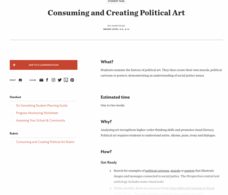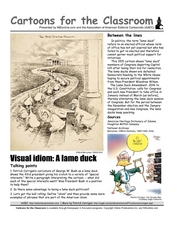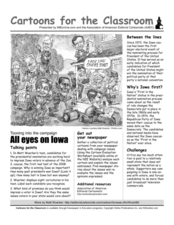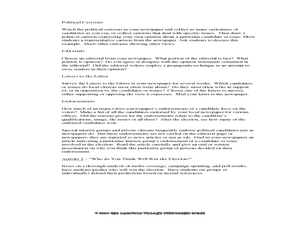Curated OER
How to Draw Caricatures
Caricature drawing is fun, and can help learners explore the principle of design and content specific vocabulary. They view a video and books that use character drawings, discuss vocabulary such as exaggeration, proportion, and symmetry,...
Curated OER
What Portraits Reveal
Young scholars examine how portraits can tell us more about people of the past than just what they looked like. They compare three portraits of U.S. Presidents, analyze portraits of Americans from the Revolutionary War, and write a...
Curated OER
Cartoons for the Classroom: A Study in Early Caricatures
In this current events worksheet, students analyze caricatures of Barak Obama through the years and respond to 3 talking point questions.
Curated OER
Modeling Reality
Students identify what a role model is and what characteristics such a person should possess. They discuss a new trend in character role model figurines, which some believe perpetuate racial and ethnic stereotypes.
Teaching Tolerance
Consuming and Creating Political Art
A picture is worth a thousand words, but political art may be worth even more! After examining examples of political cartoons, murals, and other forms of public art, class members create their own pieces to reflect their ideals and...
Curated OER
An Anecdote is Worth a Thousand Pictures
Students identify anecdotes in speeches and the purposes that politicians use the anecdotes for. They create personal anecdotes for the class to hear, and students decide if the anecdote is real or fabricated.
Curated OER
Satire: A Matter of Tone
Satire, anyone? After a review of terms associated with satire, viewers are directed to craft a 500-600 word piece of satire about a familiar hypocrisy.
National WWII Museum
Dr. Seuss and WWII
What famous children's author and illustrator created World War II political cartoons featuring such subjects as fascism, the war effort, discrimination, and the dangers of isolationism? The who in this story is Dr. Seuss, and what...
Curated OER
Compare the Presidents
How are Nicolas Sarkozy and Barack Obama similar? How are they different? Look at two visual representations of them; what kind of first impression does they give you? After comparing the presidents, learners complete a proverb matching...
Curated OER
Cartoons for The Classroom: Lame Duck Congress
Clear up "lame duck" congressional confusion with this political cartoon analysis worksheet. Background information on the concept's history and current use is provided, and 2 cartoons give a past and present context. Three talking...
Curated OER
Editorial Cartoons: A Historical Example of Immigration Debates
Eleventh graders analyze political cartoons. In this American History lesson, 11th graders research the Chinese Exclusion Act and the current arguments about immigration to the United States. Students create a graphic...
Curated OER
Cartoons for the Classroom: Bushwhacked
In this historical events worksheet, students analyze political cartoons that feature caricatures of President George W. Bush. Students respond to 3 short answer questions.
Curated OER
Cartoons for the Classroom: All Eyes on the Iowa Caucus
Explore the primary elections through political cartoons. Three talking points guide deeper thinking as pupils analyze a cartoon, which depicts the 2008 campaigning in Iowa. Analysts identify caricatures, research why winning Iowa is...
Curated OER
Arab-Israeli Conflict Lesson Plan
Students identify the key participants in the Arab-Israeli conflict. They create a caricature that is both Israeli and Arab. One side should be labeled with the feelings, thoughts, emotions of the Arabs and the other side is from an...
Curated OER
The Campaign: Issues and Strategies. What do you think?
Pupils research a candidate in an election and discuss how the media portrays that candidate and how the media influences voters. In this candidate lesson plan, students also distinguish fact from opinion, look at political cartoons,...
National First Ladies' Library
All the News That's Fit to Draw: Political Cartooning and the Presidency
Students research, analyze and study the history of political cartooning in the United States. They recognize a political cartoon, be able to identify the main idea, the symbols and the exaggeration and caricature in political cartoons....
Curated OER
Cartoons for the Classroom: Now That's Debatable!
In this current events worksheet, students analyze political cartoons that feature caricatures of George Bush and John Kerry. Students respond to 3 talking point questions.
Curated OER
Political Cartoons Illustrating Progressivism and the Election of 1912
Young scholars study a current political cartoon to introduce the ideas of symbolism, humor, exaggeration, and caricature in editorial cartoons. They study cartoons from the past to gain an understanding of the culture of 1912.
Curated OER
Remembering Chuck Jones
Pupils investigate the art of animation and various cartoon characters created by Chuck Jones. They complete a Webquest, watch video clips, draw a cartoon character, answer discussion questions, and create an original caricature of a...
Curated OER
Rock Speaks
Students create primitive forms and caricatures to represent meaningful figures and/or events in their own lives, present their own works to the class, and attempt to interpret the relevant meaning from other students' work.
Curated OER
From the Kitchen Table to the House of Commons
Students examine cartoons that include caricatures of all leaders of federal parties.
Curated OER
Cartoons for the Classroom: Tooning into the Candidates, Hillary Clinton
In this current events worksheet, students analyze a political cartoon about Hillary Clinton and respond to 3 talking point questions.
Curated OER
The Notebook by Nicholas Sparks
In this literature worksheet, students respond to 5 short answer and essay questions about The Notebook. Students may also link to an online interactive quiz on the novel at the bottom of the page.
Curated OER
Cartoons for the Classroom: Keep Current Through a Cartoonist's Commentary
In this current events worksheet, students analyze political cartoons about the Middle East and American domestic issues. Students respond to 4 talking point questions.






